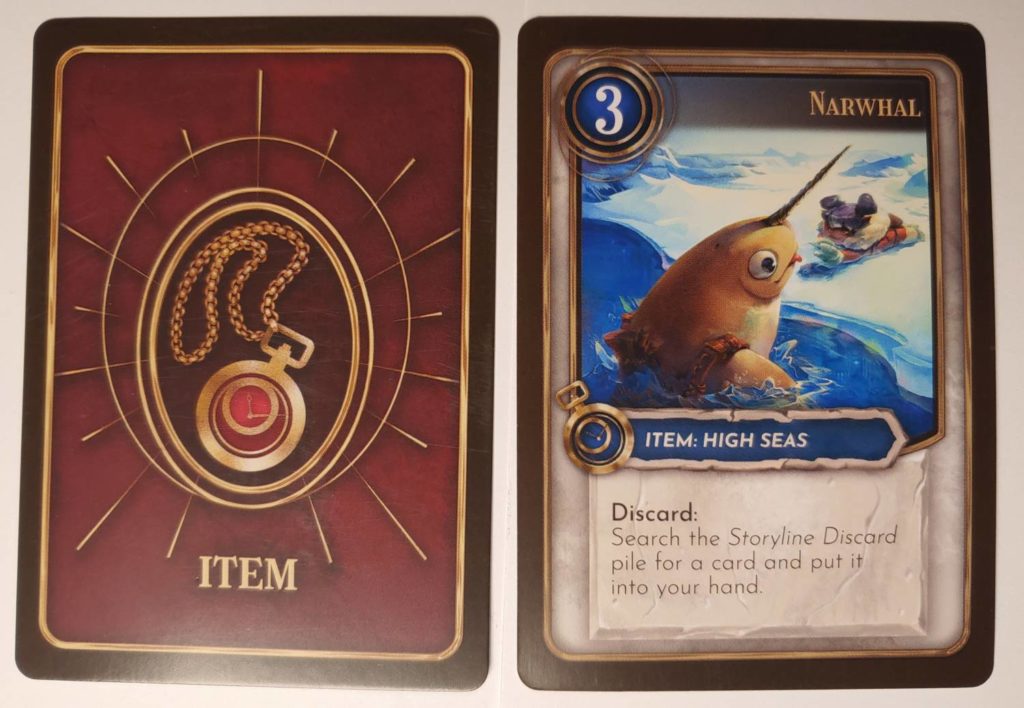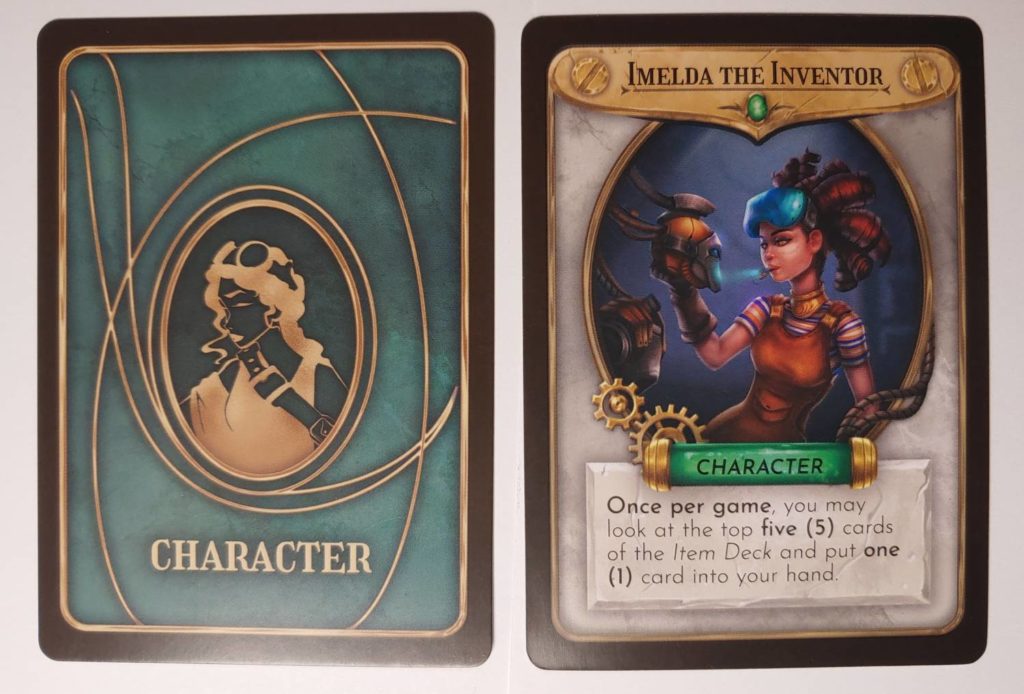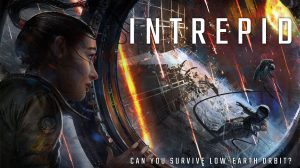In the futuristic world of Fjerograd, the Elder Gamestormer is seeking an apprentice, and it could be you! Are you able to conjure a game the world will never forget?
Overview
Gamestormers is a 3-6 player game for ages 9+ that clocks in at 45-60 minutes. In Gamestormers, your goal is to collect Character, Item, Mechanic, and Storyline cards to construct a narrative for a new game. Players score victory points from card values, card alignment, arena tokens, and end game voting. The player with the most victory points after 5 rounds wins.
How To Play

Each player begins with 3-4 dry erase cards, a dry erase marker, an instruction card, and a Notebook Playmat, which is the tableau where the cards of your emerging game narrative are stored. There are separate decks for Characters, Mechanics, Items, and Storylines, all combining to make up your tableau. The goal is to fill your Notebook Playmat with cards that both complement each other and create a compelling game narrative.
Game cards consist of five genres: Civilizations, Fantasy, High Seas, Sci Fi, and Horror. Players can choose whether to acquire a single genre of items, mechanics, and storylines to tell a traditional story, or to mix and match genres to create an unexpected (and often delightful) new narrative.
On your turn, choose any two (2) of the available five (5) actions:
- Item Market—Select an Item card from the table and add it to your hand.
- Theater—Roll the Theater Dice and sketch your own Storyline, Mechanic, or Item card on a blank dry erase card. Add it to your Notebook Playmat.
- Forum—Draw the top three cards from either the Mechanic or Storyline deck, keeping one and discarding the other two.
- Temple—Use the ability of an Item or Storyline card (text instructions on the card bottom) in your hand, then discard that card.
- Arena—Take a token to enter the Arena. Limit two players per round. Those players will each draw one Item, one Mechanic, and one Storyline card, then take 1 minute to pitch a game narrative. Each player at the table then votes for the better pitch, with the pitch winner keeping both Arena tokens (each worth one victory point). Both contestants keep one card and discard the other two.
Once all players take their two actions and resolve the Arena, each player adds one card from their hand to an empty slot on their Notebook Playmat.
End Game Scoring

After five rounds of play, each player will make their Game Pitch from the cards they have stored on their Notebook Playmat. A secret ballot vote (using the dry erase cards) will choose the winner of the Designer’s Choice Award. The award itself is not to win the game… it is for bragging rights! However, any player who voted for the winner gains 2 victory points! Now, players tally up the victory points in their Notebook Playmats as well as any special scoring to determine who won.
Kudos (What Worked)
 Far and away the most exciting aspect of this game is the prolific and stunning artwork. Every card of Gamestormers is lovingly crafted, evocative, and rich with detail. The Notebook Playmats offer large scale landscapes of exotic worlds, stimulating the imagination. The component quality is consistently high, especially the six custom dice that feature different icons, further prompting players to imagine new and exciting story combinations. The artwork on the cards—crackling with color, action, and story potential—are designed to encourage players to stretch their imaginations.
Far and away the most exciting aspect of this game is the prolific and stunning artwork. Every card of Gamestormers is lovingly crafted, evocative, and rich with detail. The Notebook Playmats offer large scale landscapes of exotic worlds, stimulating the imagination. The component quality is consistently high, especially the six custom dice that feature different icons, further prompting players to imagine new and exciting story combinations. The artwork on the cards—crackling with color, action, and story potential—are designed to encourage players to stretch their imaginations.



Quibbles (What Missed)
As beautiful as the artwork and components are, sadly, my play group did not enjoy it.
The core of the game is to select cards that form an interesting story while creating opportunity for player interaction. That’s where the fun is. Unfortunately, the choices in Gamestormers seem to accidentally discourage player interactions.
For example, the Arena action is the highest point of interaction and where the game is most stressful (and thus, most compelling).
When two players enter the Arena, the pitch winner keeps one card and BOTH tokens (2 Victory Points in the end game). The loser just keeps one card. When only one player enters the Arena, that player still gets a token (worth 1 Victory Point) and a card, but the card is still a random draw from the tops of three decks, meaning the value or genre may not help the story they are building. So, entering the Arena means 1 Victory Point and a random card, while choosing the Item Market action virtually guarantees a value “3” card and avoids the risk of a bad card draw.
The only time the Arena is a good option is when you compete and win. For anyone unsure if they can fabricate a compelling story from random prompts, they will quickly discern that they are better off avoiding the risk entirely. After all, they have perfect information in the Item Market, where they can choose a high-value card or a desired genre card risk free.
Our group figured this out on round 1, resulting in no one risking an Arena matchup for the entire game. Instead, the first player to grab the Arena was uncontested, getting a small bonus instead of a delightful comedic face off. It was a big letdown. Sadly, the scoring incentivized this behavior.
The Theater action also suffered from scoring that discouraged its use. When a player takes a Theater action, they get to roll custom dice and use the prompting icons to sketch their own dry erase card. Their custom card is always valued at “2.” If the Item Market has a value “3” card for the taking, why would I sketch my own card at value “2”? My group figured this out as well, though one player insisted on drawing his own cards because it made his narrative more delightful. In the end game scoring, he was not in contention for victory because other players focused on getting higher value cards into their Notebook Playmat.
But wouldn’t that help the end game scoring to have the best narrative? You would think so…but because the voting process rewards all players who vote for the winner with two Victory Points, the vote scoring is watered down. And the design winner, who crafted the best narrative over 5 rounds, does not directly benefit from their own victory. Therefore, to put yourself in position to win, the most straightforward strategy is to focus on getting value “3” cards (the highest value) in your Notebook Playmat. Spoiler alert: There are plenty of value “3” cards to choose from, so the scoring incentivizes deck mining.
I also struggled with the basic narrative of the game. The concept of a Gamestormer required knowledge of a whole narrative framework that ultimately did not contribute to game play. Who you are, what you are doing, and why you are doing it is irrelevant. I would have appreciated a simpler setting, like you are storytellers constructing a narrative. The “game design” aspect fell flat for my group largely because there were no real game mechanisms in the Mechanic cards.

For example, the Storyline cards made sense, with cards prompting you to “Build World Wonder” or “Stop Robot Uprising.” Items made sense as well, with cards like “Serpent” and “Jetpack.” However, the Mechanic cards seemed like extensions of the Storylines, with cards prompting you to “Fire the Cannons” or “Awaken a Genie.” The Storyline cards and the Mechanic cards were not sufficiently different, leading to a healthy confusion in my group.

For Mechanics in game design, I would have expected to see mechanisms used in modern board games like “Hand Management,” “Card Drafting,” “Deck Builder,” etc. But that might have been too dry, especially for younger players. This is where the framework of the game’s narrative doesn’t help the game play. If Gamestormers were about anything else (telling a great story, casting spells to unlock runes, translating an ancient mystical text, etc.) rather than building a game pitch, there would have been no confusion.
Ultimately, the spine of the game is “place one card on your board each round.” Acquiring cards is too easy, and the best ways to score points often include little drama or challenge. As a result, Gamestormers was less “storm” and more “drizzle.”
Target Audience
Groups who like to pantomime story, create narrative on the spot, or perform for an audience will likely appreciate what Gamestormers brings to the table. If your group likes spontaneous dramatization, direct player conflict, and free association that leads to comedy and silliness, Gamestormers is for you. Also, it will really help if you have a bigger group, since Gamestormers seems more dynamic at 5 or 6 players.
While the box says ages 9 and up, I think the volume of mechanisms adds too much rules grit for young players. I can see this game needing significant adult assistance at 9 years old, perhaps not so much at 12 years old.
Final Thoughts
The right gaming group can absolutely have fun playing this game, especially groups who care more about having a great experience and less about winning and losing. I think the reason my group did not like Gamestormers is that we are mostly introverts who enjoy strategy and puzzle-forward games where you are rewarded for optimal scoring strategies. The game narrative was counterintuitive, making it hard for me to engage with the theme, and Gamestormers’ “game design” aspect fell flat for us because no actual game mechanisms were included in the Mechanic deck.
By a mile, the best part of the game was the artwork. I also like the idea of using these components to tell interesting stories. If this were a filler game with fewer mechanisms, then it would have been more fun. Unfortunately, it includes a lot of bookkeeping and hoop-jumping that distracted me from what I wanted to be doing—telling an unexpected story.
If you want a quick, fun filler game that helps kids begin to tell a story, try Rory’s Story Cubes. If you want a different card-based adventure that plays in about the same time, I strongly recommend Call to Adventure, which is thematically and mechanically exceptional. You can watch Meeple Mountain’s Call to Adventure video review to see the game in action.











Add Comment